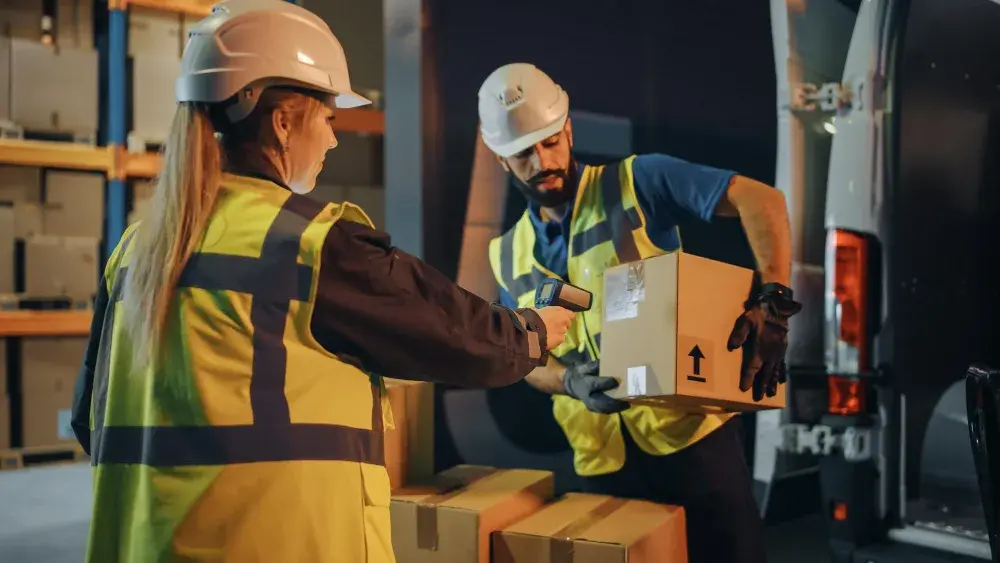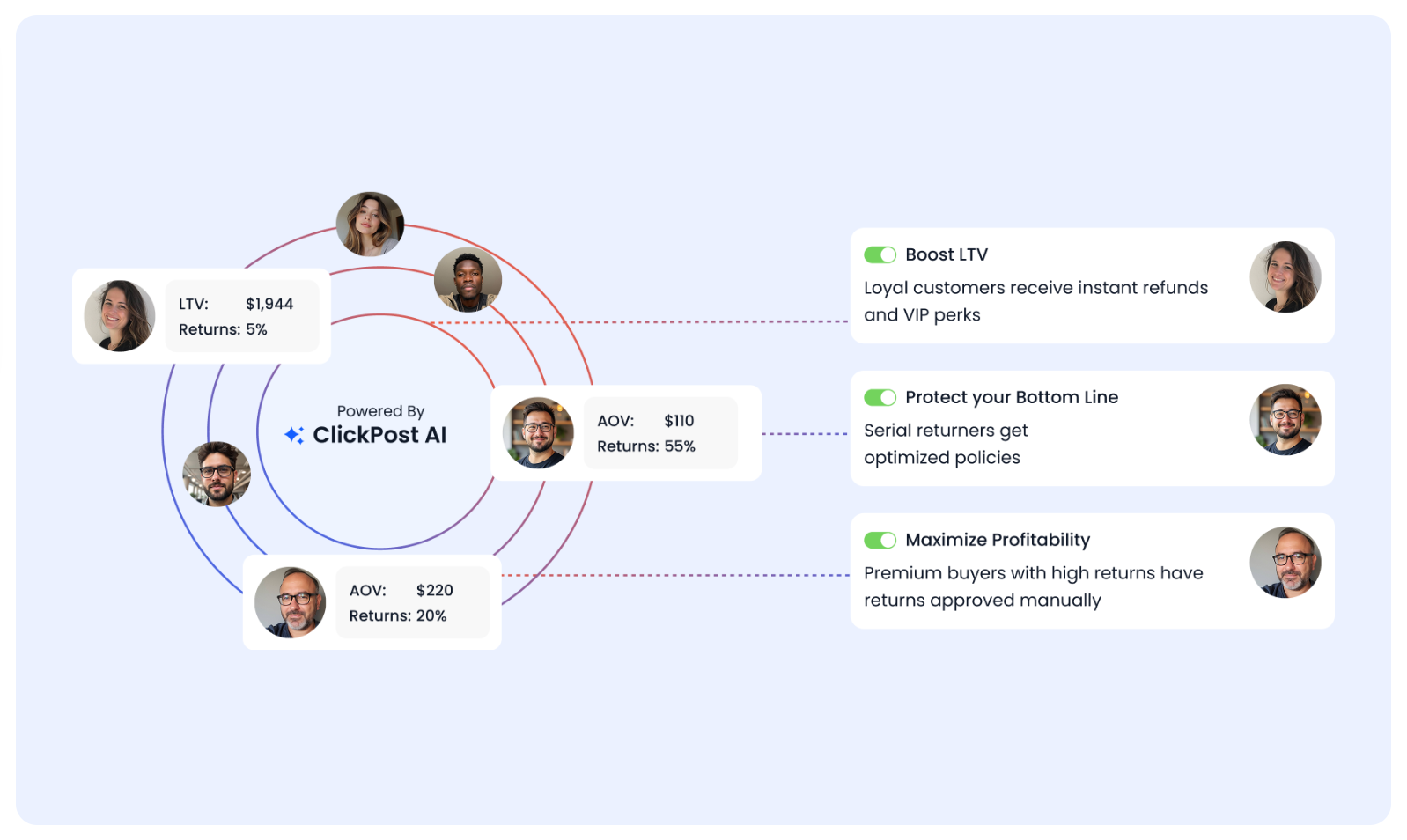Top 10 Reverse Logistics Software in 2026

What we’ll cover
Introduction
Managing product returns is no longer just an afterthought in eCommerce businesses—it is now a defining factor in customer satisfaction, operational efficiency, and overall profitability. The reverse logistics market is growing rapidly. Projections estimate its value will reach $957.27 billion by 2029, reflecting a CAGR of 5.3%. As businesses continue to offer free returns to stay competitive, the costs associated with handling returns, recycling, and product recovery are becoming a significant concern.
Reverse logistics software is changing the game by streamlining the returns journey, reducing transportation costs, and improving the reverse supply chain for retailers and manufacturers alike. Traditional logistics software is built to deliver products efficiently, but managing their return requires specialized tools that can optimize the returns process, repair workflows, and ensure real-time visibility across logistics operations.

Why businesses need reverse logistics software?
- Growing return volumes – With an increase in online shopping, returns have skyrocketed, making manual processing impractical and costly.
- Circular economy and sustainability – Reverse logistics solutions help businesses achieve sustainability goals by recycling or repurposing returned products, reducing waste.
- Cost optimization – Reverse logistics processes significantly reduce costs by automating repairs, replacements, and inventory management.
- Enhanced customer experience – Customers expect seamless returns with real-time insights on refund or exchange statuses.
With reverse logistics software, businesses can optimize their returns process, minimize financial losses, and create a competitive advantage by offering an effortless return experience.
What is Reverse Logistics Software?
At its core, reverse logistics software is designed to manage returns, repairs, recycling, and refurbishments in the reverse supply chain. Unlike traditional logistics operations, which focus on delivering goods from retailers or manufacturers to customers, reverse logistics software solutions help facilitate the returns process. This process involves everything from the customer back to the seller, manufacturer, or designated processing center.
This software automates the reverse logistics journey, allowing eCommerce businesses to track returned products, classify repair-worthy inventory, optimize recovery processes, and ultimately control costs. By integrating real-time visibility and automation, it simplifies an otherwise time-consuming and resource-intensive process.
How does reverse logistics software work?
- Returns authorization: Customers initiate returns through a self-service platform, generating return labels and return tracking information.
- Inventory and recovery processing: The software sorts returned products into categories: repair, refurbish, resell, recycle, or dispose of.
- Automated workflows: Reverse logistics software integrates with eCommerce systems and logistics providers to automate returns processing.
- Quality control and fraud detection: AI-powered validation ensures that returned products meet refund or exchange criteria to prevent fraud.
- Sustainability and circular economy integration: Businesses can use reverse logistics software to support their sustainability goals by recycling returned products, repurposing parts, and optimizing waste reduction.
By using reverse logistics management software, companies streamline processes, gain real-time insights, and reduce operational inefficiencies, making returns an opportunity rather than a liability.
Top 10 Reverse Logistics Software in 2026
Effective returns management is critical for e-commerce businesses that aim to optimize post-purchase operations, reduce unnecessary overhead, and enhance customer retention. With the right returns management services, companies can automate returns, minimize errors, and optimize workflows for increased operational efficiency.
Below is a detailed analysis of the top 10 reverse logistics software solutions, their key features, and what makes them suitable for different business needs
| # | Software | Best For | Key Features | Limitations |
| ClickPost | Mid-to-Enterprise eCommerce | Automated returns, carrier optimization, real-time tracking, fraud prevention, branded portal | End-to-end automation, strong analytics |
Focused on larger operations
|
| Loop Returns | Mid-sized eCommerce brands | Automated returns, customizable workflows, fraud prevention | Simple and easy to use |
Limited logistics visibility
|
| Outvio | High-volume businesses | 100% automated returns, intelligent routing, AI upselling, analytics | Turns returns into revenue |
Pricing may deter small firms
|
| Returnly | Brands focused on retention | Instant credit, flexible return modes, AI fraud detection, branded portal | Speeds up refunds |
Weak offline integration
|
| Narvar | Enterprise retailers | Flexible return options, analytics, exchange prompts, system integration | Improves visibility & policies |
Expensive for smaller firms
|
| Happy Returns | Omni-channel retailers | Box-free drop-offs, bulk shipping, instant refunds, eco-friendly | Reduces packaging waste |
Depends on Return Bar network
|
| ShipBob | 3PL + Fulfillment seekers | Integrated logistics, restocking automation, return tracking | Unified forward & reverse ops |
Overkill for returns-only users
|
| FarEye | Large retailers & logistics | AI-based routing, dynamic carrier allocation, sustainability insights | Predictive optimization |
Too complex for SMBs
|
| ReverseLogix | Enterprises with complex ops | Unified dashboard, RMA automation, analytics, multi-channel support | Full-chain control |
Costly & heavy customization
|
| ReturnGo | Mid-sized eCommerce | Exchange optimization, branded portal, inventory disposition | Encourages exchanges over refunds |
Limited carrier integrations
|
1. ClickPost – The best returns management solution for e-commerce
ClickPost is a leading AI-powered returns management platform designed to simplify returns processes for online businesses. The platform integrates with 500+ carrier partners, offering a seamless returns experience while providing real-time insights into return trends. By leveraging automation, ClickPost reduces manual intervention, ensuring faster processing times and improved accuracy in e-commerce systems.
Key features of ClickPost reverse logistics processes
-
Automated returns processing: Instantly authorizes returns, assigns the most suitable carrier, and tracks shipments.
-
Carrier optimization: Automatically selects the best shipping provider based on location, service level, and cost.
-
Real-time tracking & visibility: Customers receive status updates at every step of the returns journey.
-
Fraud prevention mechanism: AI-powered fraud detection flags suspicious return requests.
-
Branded self-service returns portal: Businesses can offer a customized return experience with seamless integration.
AI Identifies your loyalists
Treat them like royalty with personalized returns experience, maximize LTV

Personalize returns experiences
Choose which segment gets access to what offers. Optimize policies to deter abuse.

2. Loop Returns
Loop Returns helps Shopify and DTC brands optimise returns with a focus on customer retention. It provides options for variant exchanges, store credit incentives, and item-keeping workflows that minimise reverse logistics costs.
Key features:
-
Allows shoppers to initiate returns via mobile-optimised portals.
-
Offers options like returnless refunds and dynamic product recommendations.
-
Integrates with Shopify and commerce tools for fast deployment.
-
Offers detailed analytics dashboards for actionable insights.
-
It supports in-store returns, carrier pickups, and Return Bar integrations.
Loop Returns uses a flat-fee or usage-based model. It is best for retailers who want to convert returns into new sales or save money through innovative workflows.
3. Outvio
Outvio is an end-to-end post-purchase automation platform that helps e-commerce businesses streamline order fulfillment, returns processing, and customer engagement. It allows enterprises to automate exchanges and turn returns into revenue opportunities.
Key features
-
100% automated returns processing: Helps reduce manual effort by automating return approvals and label generation.
-
Intelligent routing for returned products: Optimizes warehouse operations and inventory allocation.
-
AI-based cross-selling & up-selling: Converts return requests into sales opportunities.
-
Advanced returns analytics: Helps track return reasons and trends to optimize future returns.
Outvio is ideal for businesses handling a high volume of returns and looking for scalable automation. However, its pricing model may not be cost-effective for small businesses.
4. Returnly
Returnly is a customer-centric returns platform that offers instant credit for exchanges. It reduces refund processing time and improves businesses' cash flow.
Key features
-
Instant store credit: Customers can shop again before returning an item.
-
Flexible return methods: Support mail-in, in-store, and drop-off returns.
-
AI-based fraud detection: Identifies potential fraudulent returns.
-
Customizable returns portal: Helps enhance brand consistency.
Returnly is best for businesses aiming to improve customer retention through fast refunds. However, it primarily focuses on online returns, making it less ideal for brick-and-mortar store integrations.
5. Narvar
Narvar is a post-purchase experience platform that optimizes return handling with a focus on customer experience and return analytics.
Key features
-
Flexible return options: Supports home pickup, store drop-offs, and self-service returns.
-
Data-driven insights: Helps retailers improve return policies based on analytics.
-
Automated exchange recommendations: Encourages customers to swap products instead of refunds.
-
Seamless integration with existing systems: Works with major e-commerce platforms.
Narvar is best for enterprise retailers looking to improve return visibility. However, its pricing structure may not be feasible for small businesses.
6. Happy Returns
Happy Returns is a returns management platform focused on streamlining in-person returns for e-commerce businesses. It enables customers to drop off their returns at designated Return Bars without requiring boxes or labels. This system enhances the returns experience while reducing shipping costs and environmental impact.
Key features
-
Box-free, label-free returns: Customers can drop off returns at physical locations without packaging.
-
Bulk shipping reduces costs: Returns are aggregated and shipped back to retailers in bulk, minimizing transportation costs.
-
Immediate refunds & exchanges: Customers receive instant refunds upon drop-off.
-
Software-driven returns processing: Automates return workflows and enhances visibility.
-
Sustainability-focused: Reduces packaging waste and carbon footprint with aggregated returns.
Happy Returns is ideal for retailers wanting to offer frictionless, eco-friendly in-person returns. However, its reliance on physical drop-off locations may make it unsuitable for businesses operating solely online or in regions where Return Bars are unavailable.
7. ShipBob
ShipBob is a third-party logistics (3PL) provider offering end-to-end returns processing alongside its core order fulfillment services. By integrating returns handling with warehousing and shipping, ShipBob ensures a seamless reverse logistics workflow for e-commerce brands.
Key features
-
Integrated returns and fulfillment: Manages both forward and reverse logistics under one platform.
-
Real-time tracking for returns: Provides visibility into the returns process with automated updates.
-
Automated restocking & inventory management: Ensures returned products are sorted, restocked, or disposed of efficiently.
-
Customizable return workflows: Retailers can set return policies, restocking rules, and automated refund triggers.
-
Multi-warehouse support: Enables businesses to route returns to the nearest warehouse for faster processing.
ShipBob is best for e-commerce brands seeking an all-in-one fulfillment and returns management solution. However, businesses that only need returns software (without order fulfillment) may find its pricing less cost-effective.
8. FarEye
FarEye is an AI-powered logistics platform that helps businesses optimize their reverse logistics operations. By leveraging real-time data and predictive analytics, FarEye reduces return transit times and enhances operational efficiency for large-scale retailers and logistics providers.
Key features
-
AI-powered returns routing: Determines the most efficient return paths based on real-time data.
-
Dynamic carrier allocation: Automatically assigns the best carrier for return pickups.
-
Intelligent dispositioning: Helps businesses decide whether to restock, repair, recycle, or liquidate returned products.
-
Customer communication & tracking: Provides live monitoring and automated notifications for improved transparency.
-
Sustainability optimization: Promotes waste reduction by optimizing return shipments and reselling opportunities.
FarEye is ideal for enterprises looking for AI-driven efficiency in reverse logistics. However, its complexity may not suit small businesses, which may not need advanced AI-driven analytics.
9. ReverseLogix
ReverseLogix is a cloud-based reverse logistics solution designed to help retailers, manufacturers, and logistics providers efficiently manage returns, repairs, and warranty claims. It offers end-to-end automation, ensuring seamless coordination between all stakeholders in the reverse supply chain.
Key features
-
Unified returns management dashboard: Centralizes returns, repairs, and resales in one platform.
-
Automated RMA (Return Merchandise Authorization): Ensures faster return approvals and processing.
-
Reverse logistics data insights: Provides return pattern analytics to help businesses reduce return rates.
-
Multi-channel returns support: Works across e-commerce platforms, retail stores, and marketplaces.
-
End-to-end workflow automation: Handles product returns, repairs, refurbishments, and liquidation.
ReverseLogix is ideal for enterprises with complex reverse logistics needs. However, smaller businesses may find its enterprise-level pricing and customization options overwhelming.
10. ReturnGo
ReturnGo is a returns management software that enables businesses to automate return requests, exchanges, and refunds while optimizing inventory recovery. It focuses on reducing refund rates by encouraging product exchanges over refunds.
Key features
-
Intelligent exchange recommendations: Encourages customers to swap items instead of refunds.
-
Customizable returns portal: Businesses can create branded return experiences.
-
Inventory disposition management: Automates restocking, liquidation, and recycling decisions.
-
Real-time returns tracking: Provides customers with up-to-date return status notifications.
-
Integration with e-commerce platforms: Works with Shopify, WooCommerce, and other major platforms.
ReturnGo is best for mid-sized e-commerce retailers looking to optimize exchanges and reduce refund rates. However, its carrier integration is limited, requiring third-party logistics providers for broader return shipping coverage.
6 Key Benefits of Reverse Logistics Software
An effective reverse logistics solution reduces costs and enhances efficiency, sustainability, and customer retention. Here are the key benefits of investing in reverse logistics software solutions.
| Benefit | Key Takeaway | Impact |
| Reduced Return Processing Costs | Automates return workflows and minimizes manual handling. |
Cuts operational costs and reduces warehouse congestion.
|
| Faster Refunds & Exchanges | Real-time visibility and automated refund triggers. |
Improves customer satisfaction and repeat purchases.
|
| Improved Inventory Recovery | Reintegration of returned goods via categorized workflows. |
Enhances reuse, resale, and sustainability.
|
| Enhanced Customer Experience | Self-service portals, live tracking, and flexible policies. |
Builds trust, boosts loyalty, and reduces return anxiety.
|
| Fraud Detection & Prevention | AI flags suspicious returns and validates products. |
Reduces loss and strengthens business security.
|
| Data-Driven Insights | Real-time analytics identify trends and root causes. |
Enables smarter decisions and operational efficiency.
|
1. Reduced return processing costs
Processing returns manually is time-consuming and leads to high operational costs. With automated reverse logistics software, businesses can:
-
Optimize returns processes through AI-driven automation.
-
Minimize manual handling and warehouse congestion.
-
Improve control over returned products, reducing inventory mismanagement.
For example, an eCommerce business using reverse logistics software reduced processing costs by automating returns workflows and optimizing repair and resell cycles.
2. Faster refunds & exchanges
Delays in refunds can damage customer satisfaction and erode brand loyalty. Reverse logistics solutions provide:
-
Real-time visibility into return status.
-
Automated refunds and exchanges once a returned item is verified.
-
Faster integration with payment processors, reducing refund time.
A study shows that 92% of consumers are more likely to shop again from brands that process refunds or exchanges quickly.
3. Improved inventory recovery
Returned products often become lost inventory due to inefficient reverse supply chain processes. Reverse logistics management software enables:
-
Seamless reintegration of items into the supply chain.
-
Categorization of returned products based on repair, resale, or disposal value.
-
Reduction of waste by recycling defective items.
Retailers using automated recovery systems have seen improvement in inventory reusability, enhancing sustainability efforts.
4. Enhanced customer experience
An optimized returns process directly impacts customer satisfaction. The following features increase customers' confidence in their purchases and reduce return hesitancy.
-
Self-service return portals.
-
Real-time tracking and notifications.
-
Flexible exchange and refund options.
A smoother returns process fosters brand trust and repeat business.
5. Fraud detection & prevention
Returns fraud costs businesses billions annually. AI-powered reverse logistics software solutions:
-
Detect suspicious return patterns and flag fraudulent claims.
-
Implement real-time insights to track customer return behavior.
-
Use barcode scanning and image verification to validate returned products.
For example, a retailer using fraud detection tools in reverse logistics software can significantly reduce fraud-related losses, reinforcing business security.
6. Data-driven insights for smarter decision-making
Reverse logistics solutions provide real-time analytics, offering:
-
Insights into returns trends and root causes.
-
Identification of frequently returned products to improve quality control.
-
Reports that help retailers minimize transportation costs and reduce waste.
With AI-driven analytics, businesses streamline processes, enhance operational decision-making, and gain a competitive advantage.
Conclusion: The future of reverse logistics is intelligent and automated
The rise of e-commerce businesses has placed greater emphasis on optimizing reverse logistics. Managing returns effectively is no longer a costly burden—it is an opportunity to build brand loyalty, improve cash flow, and reduce environmental impact.
Platforms like ClickPost, ReverseLogix, and FarEye offer data-driven insights, automated workflows, and AI-powered optimizations to help businesses enhance customer experience while maximizing profitability. By choosing the right returns management platform, companies can transform returns into a growth opportunity rather than an operational setback.
FAQ's
1. What features should I look for in reverse logistics software?
An ideal returns management platform should include automated return approvals, real-time tracking, fraud prevention, smart dispositioning, and integration with inventory systems. These features enhance operational efficiency and improve consumer experience.
2. Can reverse logistics software help prevent return fraud?
Yes. Most advanced returns management solutions use AI-based fraud detection, which analyzes return patterns, flags suspicious requests, and prevents unauthorized refunds.
3. How does it improve the customer experience during returns and exchanges?
Reverse logistics solutions simplify returns by automating approvals, providing real-time tracking, and offering seamless exchange options. It enhances customer trust and retention, leading to higher repeat purchases.
4. How does it handle failed return pickups and lost shipments?
Most returns management platforms have automated reattempt scheduling, alternative return methods, and customer communication tools to minimize return failures and lost shipments.
5. Is reverse logistics software suitable for small businesses?
Yes, many platforms offer scalable pricing models that allow small and mid-sized businesses to benefit from automation without high upfront costs. Solutions like ReturnGo and Loop Returns are designed for smaller e-commerce brands.


.png?width=879&height=549&name=Page%2074%20(1).png)
